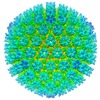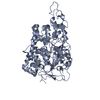[English] 日本語
 Yorodumi
Yorodumi- EMDB-2435: Protein Interactions in the Murine Cytomegalovirus Capsid Reveale... -
+ Open data
Open data
- Basic information
Basic information
| Entry | Database: EMDB / ID: EMD-2435 | |||||||||
|---|---|---|---|---|---|---|---|---|---|---|
| Title | Protein Interactions in the Murine Cytomegalovirus Capsid Revealed by CryoEM Protein Protein | |||||||||
 Map data Map data | Reconstruction of Murine Cytomegalovirus | |||||||||
 Sample Sample |
| |||||||||
 Keywords Keywords |  cytomegalovirus / cytomegalovirus /  herpes simplex virus type 1 / electron cryo microscopy / three-dimensional / major capsid protein. herpes simplex virus type 1 / electron cryo microscopy / three-dimensional / major capsid protein. | |||||||||
| Biological species |   Murid herpesvirus 1 (Murine cytomegalovirus) Murid herpesvirus 1 (Murine cytomegalovirus) | |||||||||
| Method |  single particle reconstruction / single particle reconstruction /  cryo EM / cryo EM /  negative staining / Resolution: 9.1 Å negative staining / Resolution: 9.1 Å | |||||||||
 Authors Authors | Hui W / Tang Q / Liu H / Atanasov I / Zhu H / Zhou ZH | |||||||||
 Citation Citation |  Journal: Protein Cell / Year: 2013 Journal: Protein Cell / Year: 2013Title: Protein interactions in the murine cytomegalovirus capsid revealed by cryoEM. Authors: Wong H Hui / Qiyi Tang / Hongrong Liu / Ivo Atanasov / Fenyong Liu / Hua Zhu / Z Hong Zhou /  Abstract: Cytomegalovirus (CMV) is distinct among members of the Herpesviridae family for having the largest dsDNA genome (230 kb). Packaging of large dsDNA genome is known to give rise to a highly pressurized ...Cytomegalovirus (CMV) is distinct among members of the Herpesviridae family for having the largest dsDNA genome (230 kb). Packaging of large dsDNA genome is known to give rise to a highly pressurized viral capsid, but molecular interactions conducive to the formation of CMV capsid resistant to pressurization have not been described. Here, we report a cryo electron microscopy (cryoEM) structure of the murine cytomegalovirus (MCMV) capsid at a 9.1 Å resolution and describe the molecular interactions among the ∼3000 protein molecules in the MCMV capsid at the secondary structure level. Secondary structural elements are resolved to provide landmarks for correlating with results from sequence-based prediction and for structure-based homology modeling. The major capsid protein (MCP) upper domain (MCPud) contains α-helices and β-sheets conserved with those in MCPud of herpes simplex virus type 1 (HSV-1), with the largest differences identified as a "saddle loop" region, located at the tip of MCPud and involved in interaction with the smallest capsid protein (SCP). Interactions among the bacteriophage HK97-like floor domain of MCP, the middle domain of MCP, the hook and clamp domains of the triplex proteins (hoop and clamp domains of TRI-1 and clamp domain of TRI-2) contribute to the formation of a mature capsid. These results offer a framework for understanding how cytomegalovirus uses various secondary structural elements of its capsid proteins to build a robust capsid for packaging its large dsDNA genome inside and for attaching unique functional tegument proteins outside. | |||||||||
| History |
|
- Structure visualization
Structure visualization
| Movie |
 Movie viewer Movie viewer |
|---|---|
| Structure viewer | EM map:  SurfView SurfView Molmil Molmil Jmol/JSmol Jmol/JSmol |
| Supplemental images |
- Downloads & links
Downloads & links
-EMDB archive
| Map data |  emd_2435.map.gz emd_2435.map.gz | 754.6 MB |  EMDB map data format EMDB map data format | |
|---|---|---|---|---|
| Header (meta data) |  emd-2435-v30.xml emd-2435-v30.xml emd-2435.xml emd-2435.xml | 13.2 KB 13.2 KB | Display Display |  EMDB header EMDB header |
| Images |  emd_2435.png emd_2435.png | 495.6 KB | ||
| Archive directory |  http://ftp.pdbj.org/pub/emdb/structures/EMD-2435 http://ftp.pdbj.org/pub/emdb/structures/EMD-2435 ftp://ftp.pdbj.org/pub/emdb/structures/EMD-2435 ftp://ftp.pdbj.org/pub/emdb/structures/EMD-2435 | HTTPS FTP |
-Related structure data
| Similar structure data |
|---|
- Links
Links
| EMDB pages |  EMDB (EBI/PDBe) / EMDB (EBI/PDBe) /  EMDataResource EMDataResource |
|---|
- Map
Map
| File |  Download / File: emd_2435.map.gz / Format: CCP4 / Size: 817.7 MB / Type: IMAGE STORED AS FLOATING POINT NUMBER (4 BYTES) Download / File: emd_2435.map.gz / Format: CCP4 / Size: 817.7 MB / Type: IMAGE STORED AS FLOATING POINT NUMBER (4 BYTES) | ||||||||||||||||||||||||||||||||||||||||||||||||||||||||||||||||||||
|---|---|---|---|---|---|---|---|---|---|---|---|---|---|---|---|---|---|---|---|---|---|---|---|---|---|---|---|---|---|---|---|---|---|---|---|---|---|---|---|---|---|---|---|---|---|---|---|---|---|---|---|---|---|---|---|---|---|---|---|---|---|---|---|---|---|---|---|---|---|
| Annotation | Reconstruction of Murine Cytomegalovirus | ||||||||||||||||||||||||||||||||||||||||||||||||||||||||||||||||||||
| Voxel size | X=Y=Z: 1.8 Å | ||||||||||||||||||||||||||||||||||||||||||||||||||||||||||||||||||||
| Density |
| ||||||||||||||||||||||||||||||||||||||||||||||||||||||||||||||||||||
| Symmetry | Space group: 1 | ||||||||||||||||||||||||||||||||||||||||||||||||||||||||||||||||||||
| Details | EMDB XML:
CCP4 map header:
| ||||||||||||||||||||||||||||||||||||||||||||||||||||||||||||||||||||
-Supplemental data
- Sample components
Sample components
-Entire : Murine cytomegalovirus capsid
| Entire | Name: Murine cytomegalovirus capsid |
|---|---|
| Components |
|
-Supramolecule #1000: Murine cytomegalovirus capsid
| Supramolecule | Name: Murine cytomegalovirus capsid / type: sample / ID: 1000 / Details: The sample is monodisperse in PBS buffer / Oligomeric state: icosahedral virus capsid / Number unique components: 4 |
|---|---|
| Molecular weight | Theoretical: 186.4 MDa |
-Supramolecule #1: Murid herpesvirus 1
| Supramolecule | Name: Murid herpesvirus 1 / type: virus / ID: 1 / Name.synonym: Murine cytomegalovirus Details: The virus is enveloped but the structure presented here is for the capsid only. NCBI-ID: 10366 / Sci species name: Murid herpesvirus 1 / Sci species strain: strain Smith / Virus type: OTHER / Virus isolate: STRAIN / Virus enveloped: Yes / Virus empty: Yes / Syn species name: Murine cytomegalovirus |
|---|---|
| Host (natural) | Organism:  Murine / Strain: strain Smith / synonym: INVERTEBRATES Murine / Strain: strain Smith / synonym: INVERTEBRATES |
| Molecular weight | Theoretical: 186.4 MDa |
| Virus shell | Shell ID: 1 / Name: Capsid / Diameter: 1310 Å / T number (triangulation number): 16 |
-Experimental details
-Structure determination
| Method |  negative staining, negative staining,  cryo EM cryo EM |
|---|---|
 Processing Processing |  single particle reconstruction single particle reconstruction |
| Aggregation state | particle |
- Sample preparation
Sample preparation
| Concentration | 1 mg/mL |
|---|---|
| Buffer | pH: 7 / Details: PBS |
| Staining | Type: NEGATIVE / Details: vitreous ice, no staining |
| Grid | Details: across holes in Quantifoil grids |
| Vitrification | Cryogen name: ETHANE / Chamber humidity: 100 % / Chamber temperature: 90 K / Instrument: FEI VITROBOT MARK I / Details: Vitrification instrument: FEI Vitrobot / Method: Blot for 7-9 seconds before plunging |
- Electron microscopy
Electron microscopy
| Microscope | FEI TITAN KRIOS |
|---|---|
| Electron beam | Acceleration voltage: 300 kV / Electron source:  FIELD EMISSION GUN FIELD EMISSION GUN |
| Electron optics | Illumination mode: FLOOD BEAM / Imaging mode: BRIGHT FIELD Bright-field microscopy / Cs: 2.7 mm / Nominal defocus max: 3.0 µm / Nominal defocus min: 1.5 µm / Nominal magnification: 47000 Bright-field microscopy / Cs: 2.7 mm / Nominal defocus max: 3.0 µm / Nominal defocus min: 1.5 µm / Nominal magnification: 47000 |
| Specialist optics | Energy filter - Name: FEI |
| Sample stage | Specimen holder: Autoloader of Titan Krios at liquid nitrogen temperature Specimen holder model: FEI TITAN KRIOS AUTOGRID HOLDER |
| Temperature | Min: 80 K / Max: 100 K / Average: 90 K |
| Alignment procedure | Legacy - Astigmatism: objective lens astigmatism was corrected at 250,000 times magnification Legacy - Electron beam tilt params: 0 |
| Date | Oct 15, 2009 |
| Image recording | Category: FILM / Film or detector model: KODAK SO-163 FILM / Digitization - Scanner: NIKON SUPER COOLSCAN 9000 / Digitization - Sampling interval: 6.35 µm / Number real images: 1299 / Average electron dose: 20 e/Å2 / Bits/pixel: 16 |
| Experimental equipment |  Model: Titan Krios / Image courtesy: FEI Company |
- Image processing
Image processing
| CTF correction | Details: CTFFIND |
|---|---|
| Final reconstruction | Applied symmetry - Point group: I (icosahedral ) / Algorithm: OTHER / Resolution.type: BY AUTHOR / Resolution: 9.1 Å / Resolution method: FSC 0.5 CUT-OFF / Software - Name: IMIRS / Number images used: 3467 ) / Algorithm: OTHER / Resolution.type: BY AUTHOR / Resolution: 9.1 Å / Resolution method: FSC 0.5 CUT-OFF / Software - Name: IMIRS / Number images used: 3467 |
| Details | Individual particle images were automatically boxed out from micrographs by the autoBox program in the IMIRS package, followed by manual screening to select good capsid particle images that appear perfectly intact and without contamination and signs of specimen charging. Defocus value and astigmatism parameters of each micrographs were determined with CTFFIND. Subsequent data processing includes the determination of particle orientation/center parameters, 3D reconstruction and iterative, projection-based refinement by a distributed computing approach using modular programs in the IMIRS package with recent enhancements. The distributed computing was performed entirely through on six Microsoft Windows personal computers and four Windows servers within a custom-designed MPI network. Astigmatism was taken into consideration during the correction of contrast transfer function (CTF) both in the orientation/center refinement step and the 3D reconstruction step. Using this procedure, we first obtained a 3D map from 6402 particle images from the Polara micrographs. This map has a resolution of about 11 angstrom and was used as the starting model to assist processing the higher resolution particle images of the Titan micrographs. To process the Titan micrographs, we discarded micrographs with specimen charging by evaluating the Fourier transform of the micrographs and selected 669 micrographs for in-depth data processing. From the 669 good Titan micrographs selected out through this process, we boxed 5383 particle images and determined their orientation/center parameters by using the 11 angstrom map as the starting model. These orientation/center parameters were iteratively refined against the latest 3D map by gradually including Fourier data at regions of higher spatial frequency. The iterative process was terminated when the reconstruction converges to a stable solution and no further improvement in the resolution of the map was observed. Our reconstruction converges when the high spatial frequency cut-off of the included image data reached 1/6.9 angstrom-1. The final map was obtained from 3467 particles images, all from the Titan micrographs. |
-Atomic model buiding 1
| Initial model | PDB ID: Chain - Chain ID: A |
|---|---|
| Software | Name:  Chimera Chimera |
| Details | Manual fitting in Chimera |
| Refinement | Space: REAL / Protocol: RIGID BODY FIT / Target criteria: Chimera fit-to-map |
 Movie
Movie Controller
Controller





